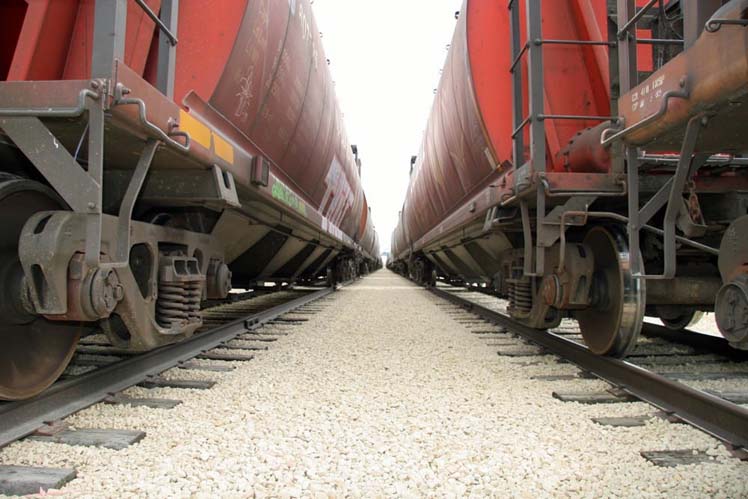
Western Canada - The North American Grain Grading Group's (NAGGG) call to axe the maximum revenue entitlement (MRE) appears to be getting
the cold shoulder from Western Canada's grain sector.
The MRE is a federal regulation that sets the annual limit the railways can earn in total hauling western grain to Thunder Bay and West Coast
ports.
The formula used to set that limit is adjusted to reflect higher railway costs, grain volume, and distance hauled.
The MRE protects farmers against the railways, which provide the only practical way to get grain to port, charging what the market will bear.
But in addition, it gives the railways the flexibility to vary rates to encourage efficiency.
For example, offering discounts for faster car loading and longer trains.
The MRE was proposed by Canadian Pacific Railway (CP) in the late 1990s, presumably to counter former Supreme Court justice, Willard Estey's 1998
recommendation to open "the Canadian rail system to competition by and between all competent railway operators so as to better serve the national
interest in obtaining competitive and efficient transportation by including shortline railways."
It served as a safety net during the transition from 100 years of regulated grain freight rates, to a deregulated rail freight market.
A CP official assured this reporter the MRE would be irrelevant because competition between the railways would result in both earning much less than the MRE
allowed.
It wasn't long until the railways routinely were just under or over their entitlement, providing clear evidence the railways don't compete to haul
grain.
Had the railways opted not to maximize their entitlement for a few years perhaps the federal government would've phased the MRE out.
But all companies have the legal obligation to maximize shareholders' returns.
CP and CN Rail now oppose the MRE, or at least the old one, arguing it discouraged the railways from investing in grain transportation.
After the Transportation Modernization Act (Bill C-49) revising the MRE became law, CN, citing "regulatory stability", announced it's buying 1,000
new, high-capacity cars.
Despite evidence of rail market power and changes to the MRE so each railway's individual investment to increase grain moving capacity, such as new hopper
cars, is part of the MRE calculation, NAGGG wants to end the MRE.
And it has asked Prairie wheat commissions and other groups to join its effort.
When asked to comment, spokes people for the wheat groups in Manitoba, Saskatchewan, and Alberta had no comment, other than that their directors hadn't had
time to study the proposal.
Don't be surprised if there's never a response.
As one industry wag put it, "This (NAGGG) proposal is about as welcome as a skunk at a garden party. We don't want to give it credibility by talking about
it."
It might work.
The newly enacted Transportation Modernization Act, formerly known as Bill C-49, includes and improves the MRE.
If history is a guide the legislation won't be revised for five to 10 years.
Why didn't it make its case earlier?
The rest of the grain sector, most farm groups and grain companies, presented a united position on C-49, including keeping, but revising the MRE.
Such unanimity, rare in Western Canada's grain industry, paid off.
The remedies sought to counter railway power are now law.
The industry made the case that grain is captive, and because of that, the railways have no incentive to invest more to meet peak demand or provide emergency
capacity in case of bad weather or derailments.
Debate around C-49 focused on poor rail service, not rates, because the MRE was being kept.
But the same arguments for balancing rail market power apply to both.
There are lots of reasons for the grain industry to ignore the NAGGG's request.
Most obvious is a consensus in supporting the MRE.
But probably more importantly is the matter has been settled, at least for now.
Shipping Prairie grain is controversial and has been since the Canadian Pacific Railway was completed in 1885.
The industry is tired of fighting.
And that's probably why calls from some farm groups for the federal government to calculate how much the railways earn hauling western grain will also be
ignored.
That is until the MRE is truly at risk.
The "costing review" case is clear.
It would reveal whether the railways are suffering financially because of the MRE, or as many suspect, including a number of economists, the railways are
making windfall profits thanks to years of efficiency gains, some of which come at farmers' expense.
There's hypothesis and then realpolitik.
Grain transportation is political and a review could make it hyper-political.
The railways will argue the costing methodology needs reforming.
That alone could take two years.
An ongoing squabble could see the government throw up its hands in frustration and just cut the MRE.
For years western farmers bitterly fought over who should get the Western Grain Transportation Act subsidy, railways or farmers.
In 1995 Ottawa scrapped the subsidy, although saving $700 million a year likely was a factor.
If the railways were truly suffering under the MRE they would demand a costing review.
They aren't.
Farmers are probably paying more to ship grain by rail than they would in a competitive market.
But they are still better off, as some economists estimate without the MRE they could pay 50 to 150 percent more to ship grain.
The new status quo might be a compromise.
But if the MRE is ever truly on the line, a costing review will provide the answer and the antidote.
The railways no more want a costing review than to implement Estey's open access recommendation.
Allan Dawson.
provisions in Section 29 of the Canadian
Copyright Modernization Act.

